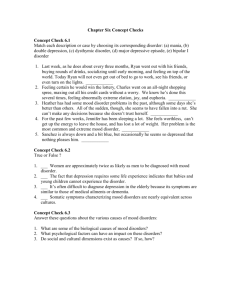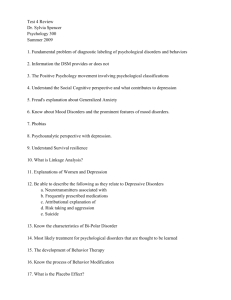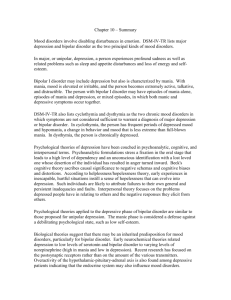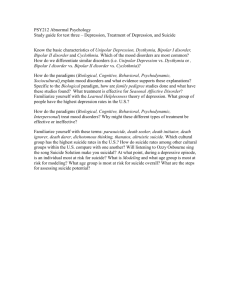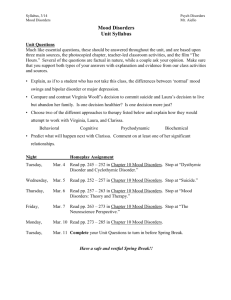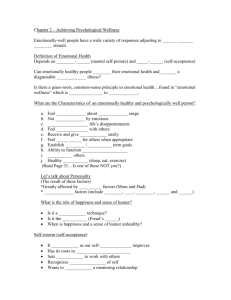13 Mood Disorders
advertisement
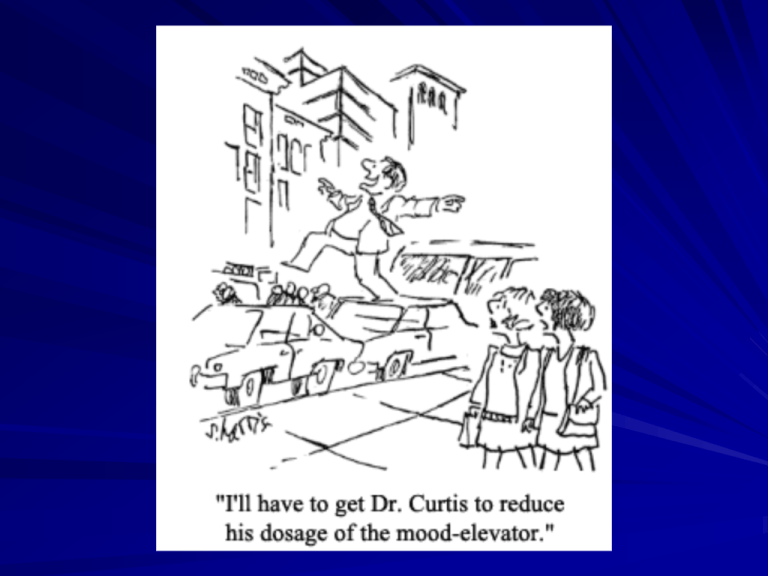
MOOD DISORDERS LECTURE OUTLINE • Historical perspective • Types of symptoms and diagnostic issues • Unipolar disorders • Bipolar disorders • Etiology • Treatments MOOD DISORDERS Historical perspective • Galen – bodily fluids and temperament • black bile and melancholia • Endogenous vs. reactive depression • Neurotic vs. psychotic depression MOOD DISORDERS Diagnostic issues DSM-IV lists 10 mood disorders • Major depressive disorder • Dysthymic disorder • Bipolar I • Bipolar II • Cyclothymic disorder • Rapid cycling depression/mania • Seasonal affective disorder • Mood disorder with postpartum onset • Mood disorder due to general medical condition • Substance-induced mood disorder MOOD DISORDERS Diagnostic issues • a number of “specifiers” (e.g., severity, chronicity) are used in diagnosis • Two broad categories – unipolar and bipolar • Two important criteria in diagnosis – duration and severity MOOD DISORDERS Diagnostic issues – Types of symptoms • mood and emotion • cognitions • behaviour and motivation • physical • the experience of depression MOOD DISORDERS Unipolar disorders – Major depression • symptoms include feelings of sadness, loss of interest or inability to experience pleasure, unexplained weight loss, difficulty sleeping, fatigue, difficulty concentrating, feelings of worthlessness or guilt, suicidal thoughts, agitation or slowing down • typically lasts 6-9 months MOOD DISORDERS Unipolar disorders – Major depression • estimates suggest about 5% of Canadians suffer from depression (1-year prevalence rate); 22% lifetime prevalence for major depression • twice as common in women – biological differences, expression of symptoms, social acceptability, role strain and stress • estimates are that half of people who recover from major depression will experience another episode; those with 2 or more episodes have 7080% chance of having another episode MOOD DISORDERS Unipolar disorders – Major depression Problem of underdiagnosis • no obvious marker for depression • many symptoms do not obviously point to depression • stigma associated with diagnosis of depression MOOD DISORDERS Unipolar disorders – Dysthymia • many of the same symptoms as major depressive disorder, but less severe • dysthymia persists for at least 2 years with only brief times mood returns to normal – chronic sadness MOOD DISORDERS Bipolar disorders – Mania • flamboyance and expansiveness • extreme or prolonged mania presumed to be psychotic state • less severe episodes are called hypomanic • some people experience mania as a “high” • there can be unipolar mania MOOD DISORDERS Bipolar disorders – Bipolar I and II • Bipolar I – one or more manic episodes and one or more depressive episodes • Bipolar II – at least one hypomanic episode and one or more episodes of major depression • Bipolar disorders less prevalent than unipolar, .8-1.6% of population • age of onset in 20s • Rapid cycling depression/mania – 4 or more episodes per year MOOD DISORDERS Bipolar disorders – Cyclothymia • long-standing pattern of alternating mood episodes that do not meet criteria for major depression or mania • criteria include duration of at least 2 years with recurrent periods of mild depression alternating with hypomania MOOD DISORDERS Bipolar disorders – Seasonal Affective Disorder (SAD) • vulnerable to changes in sunlight, especially fall and spring • prevalence rates of 4-6%, found more often in northern latitudes • many SAD symptoms opposite of those found in major depression – increase in appetite, weight gain, more sleep MOOD DISORDERS Bipolar disorders – Seasonal Affective Disorder (SAD) • hormone melatonin • photoherapy MOOD DISORDERS Etiology – Psychological models • Psychodynamic – fixation at oral stage • mourning and melancholia – introjection of lost loved one, anger turned inwards • Depressive personality • Attachment – Bowlby, anaclitic depression, introjective depression MOOD DISORDERS Etiology – Psychological models • Cognitive – Beck – negative cognitive triad • negative schemata • cognitive distortions – selective abstraction, arbitrary inference, overgeneralization, magnification and minimization MOOD DISORDERS Etiology – Psychological models • Learned helplessness and causal attributions – Seligman • Life stress – especially loss experiences • Interpersonal effects – marital violence, expressed emotion (EE) • 3 components of EE – criticism, hostility, overinvolvement MOOD DISORDERS Etiology – Biological models • Genetics – first degree relatives of people with unipolar disorder have 30-35% prevalence rate for depression; second degree relatives, 12-15% prevalence rate • Twin study (McGuffin et al., 1991) – Concordance rates of 53% for MZ twins, 28% for DZ for unipolar disorder MOOD DISORDERS Etiology – Biological models • Twin study (Bertelsen et al., 1977) – Concordance rates of 67% for MZ twins, 20% for DZ for bipolar disorder • Neurotransmitter deficiencies – catecholamines (NE and serotonin) • Monoamine hypothesis – shortage of NE, dopamine, and serotonin MOOD DISORDERS Etiology – Biological models • EEG findings – higher alpha readings in left front region • Sleep disturbances – decrease in slow wave sleep and earlier onset of REM • MRI and PET studies show increased ventricle size and decreased activity in left lateral prefrontal cortex MOOD DISORDERS Treatment – Psychological models • Depression often improves without treatment • Cognitive therapy • Behavioural strategies • Interpersonal therapy MOOD DISORDERS Treatment – Biological models • Antidepressant therapy – MAOs, tricyclics, selective serotonin reuptake inhibitors (SSRIs) • Mood stabilizers – lithium carbonate for bipolar • Combining pharmacotherapy and psychological therapy • ECT – a controversial treatment MOOD DISORDERS SUMMARY • Mood disorders are very common mental disorders, yet they often go undetected and untreated • There are gender differences in rates of diagnosed depression MOOD DISORDERS SUMMARY • The 2 main types of mood disorder are unipolar and bipolar • Within these 2 categories there are wide differences in severity and duration of symptoms • Biopsychosocial model appears to give the best account of mood disorders MOOD DISORDERS SUMMARY • but, not much on the social origins of depression • Bipolar appears to have a stronger biological component than unipolar disorders • There are effective psychological and biological treatments for the different mood disorders
